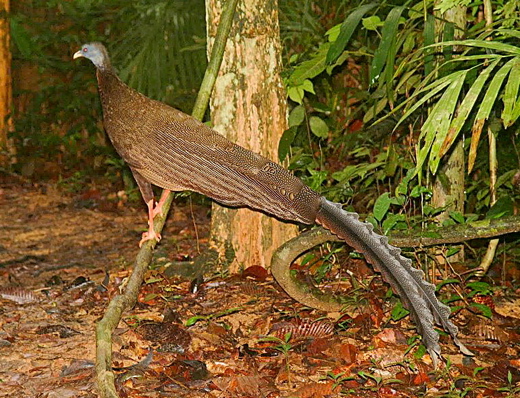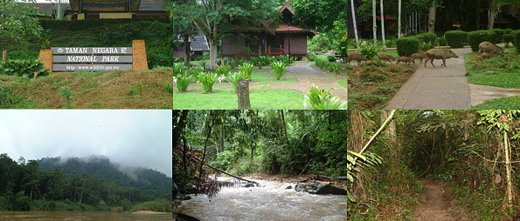To encounter a Great Argus (Argusianus argus) is a birder’s dream come true. Both the common and scientific names make reference to Argus, the Greek mythology giant with a hundred eyes, in reference to the many eyes-like markings on the wing feathers of the bird.
Gerard Goh visited Taman Negara in December 2006 and brought back memories of the Great Argus: “…our trek along the Menam Trail… sighting of the Great Argus in the afternoon of Day 3. Trekking along the Menam Trail, its call of `kow wow‘ became closer as we trekked. At the turn of a trail, we came right in full view of the pheasant bird. It did not give a hint of being in danger and even posed for our cameras (above). Heard by many, seen by few. We were indeed lucky to have this sighting.” The montage below shows some of the many scenes Gerard captured while in the park.
In May 2007 KC Tsang and Amy returned from the Danum Valley, Sabah (below) with an equally memorable encounter: “I can only say that this is a lifer for both Amy and me. Had to do a lot of trekking through the dark forest of Danum Valley to find this bird. Not only that, there were lots of leeches, and mozzies to contend with. Danum Valley is the place to find these monster birds, which can grow up to 203 cm. We could hear them calling all around us, some sounded so near, tried to follow the call, but to no avail as they knew we were around.
“Found three dance sites, but only the first one had this bird. It stayed around for about five minutes, until he noticed that I was getting too close for his comfort, and he then disappeared into the forest. Tried to find them the next day, could not see even one. But they were around all the time, calling out loudly. Saw this bird: 17th May 2007, 8.25 am.”
The Great Argus is an extremely shy jungle bird, rarely seen but often heard. During the mating season it’s loud and penetrating call triggers a response from neighbouring males. Soon, the jungle is reverberated with the characteristic kwauow. This call is issued as a challenge to other males as well as to attract females to his court.
At the start of the mating season older adult males begin to clear a space where they do their courtship dance for the benefit of the females. This so-called court is usually found in a spot where the ground vegetation is sparse. Plants are removed from the ground by scraping with his bill. Any overhanging vegetation is similarly removed. Litter is blown off with the flapping of the wings.
The bird is a brown-plumaged pheasant with a small blue head and neck, rufous red upper breast and red legs. The male is up to 200 cm in length, including its very long tail feathers. Its greatly elongated secondary wing feathers are decorated with large eye-like markings. The female is smaller and duller, with shorter tail.
The courtship dance involves spreading and raising his large wing feathers, the better to show the eye markings. The long tail feathers are also raised, flipping them towards the head. I gather the dance would be highly exciting to witness.
Images by Garard (top argus, Taman Negara montage) and KC (bottom argus).












2 Responses
Hi Readers,
I’m sorry if you have failed to access my previous blogsite to view my trip to Taman Negara. I have shifted to my new blogsite at : http://blogofsorts.wordpress.com
Here’s the link to my post on my Taman Negara trip which included the sighting of the Great Argus : http://blogofsorts.wordpress.com/2007/01/02/taman-negara-malaysia-dec-2006/
Pleasant viewing…
Gerard Goh